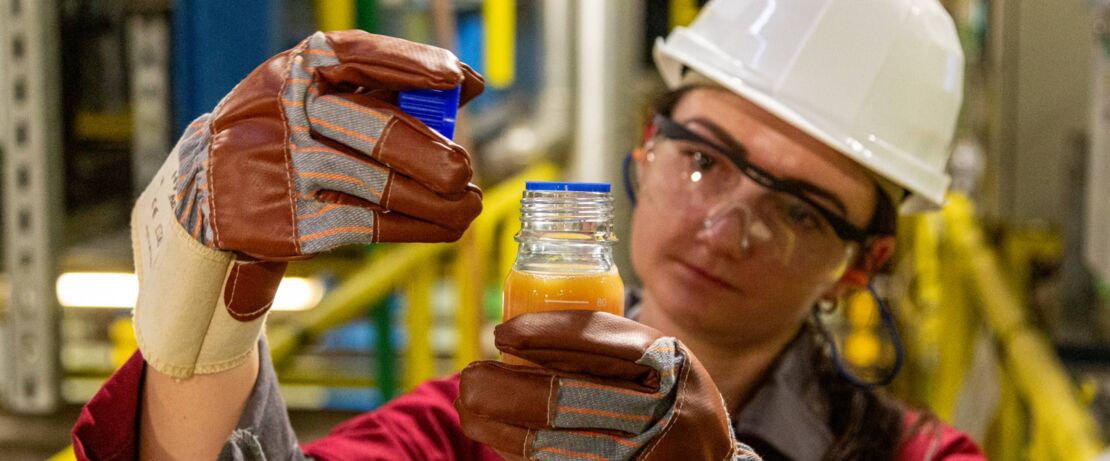


From Slovakia to new worlds
Researchers have long regarded rhamnolipids as highly gifted multi-talents. Evonik has succeeded for the first time in the world in producing these substances on a biological basis on a large scale. This breakthrough paves the way for a number of sustainable innovations.

The path to new worlds leads through an idyllic valley in the middle of Slovakia. Here, at the foot of the Low Tatras, Evonik opened its new production plant for rhamnolipids at the end of May. Surrounded by nature and close to the Hron River, the plant is the only facility in the world that can produce high-purity rhamnolipids on an industrial scale. Evonik has chosen the site in Slovenská Ľupča, Slovakia, because the plant there already has decades of experience with fermentation processes. This biological production process is the key to sustainable production of the special lipids.
They did not start from scratch: the related sophorolipids have been produced here for a long time. They were the first microbiological biosurfactants to enter the market for beauty and personal care products. With the construction of the production plant for rhamnolipids, Evonik's researchers, developers and plant engineers have successfully conquered new territory. The task now is to explore the numerous applications that this product makes possible.
Neither fossil nor tropical
But what makes this substance so special? Rhamnolipids, like sophorolipids, are glycolipid surfactants. They are produced naturally - through fermentation - by bacteria, which are removed from the material produced at the end of the manufacturing process. As biosurfactants for hand dishwashing detergents, for example, they offer an exceptional combination of cleaning performance and mildness as well as high compatibility with skin and aquatic organisms.
What's more, unlike established surfactants, neither fossil carbons nor tropical oils are required as raw materials. Rhamnolipids are produced simply from sugar with the help of bacteria from the Pseudomonas putida family in a unique and highly efficient process. It is this combination of properties that opens up opportunities for rhamnolipids in completely different markets. "Rhamnolipids are not just a new biosurfactant," says Lisa Maus, "they have a wide range of positive properties that have been known in research for decades. However, it has never been possible to produce them in high purity on an industrial scale." Maus is Director Strategy in Evonik's Care Solutions Business Unit and plans the strategic development of the technology. Among other things, she coordinates access to new sales areas. "The combination of skin and environmental compatibility with high cleaning power is extremely rare and highly interesting," adds Stefan Liebig, Technical Manager at Evonik's Goldschmidtstrasse site in Essen, who is working on researching the application of biosurfactants.

The power of micelles
The active principle of surfactants is basically simple. They consist of hydrophilic, i.e. water-loving, and lipophilic, i.e. fat-loving, parts. This is why they arrange themselves in water in a special order: hydrophilic on the outside, lipophilic on the inside - in this arrangement they form a micelle above a certain concentration, the CMC (critical micelle concentration). When rinsing, for example, the fat-loving part adheres to the dirt, the hydrophilic part to the water. This means that the greasy dirt remains in the dishwater and plates and glasses come out clean.
The outstanding properties of rhamnolipids in terms of washing power were the reason for their first big step onto the market. They have already more than proven themselves in dishwashing detergents. Rhamnolipids are particularly good foaming surfactants, which also makes them very suitable for such applications. However, what is desirable in dishwashing detergents can become a challenge during production. This is because the bacteria require air during fermentation. If it is blown through the fermentation liquid, the result would usually be something that Evonik experts ironically call a "foam party". But foam is difficult to control in plants. Evonik's experts have succeeded in solving this problem and transferring the process to an industrial scale.
Already award-winning
Rhamnolipids are also already being used in cosmetics. The product called RHEANCE® One won a gold award at the leading trade fair "in-cosmetics international" in Paris. Evonik expert Stefan Liebig also points out the double advantage in the application: "With our rhamnolipids, we give our customers the opportunity to provide consumers with cleaning and care products that are as powerful as they are sustainable."
Due to the very gentle care of the skin, facial cleansers, shampoos or baby care products are possible areas of application. Toothpaste manufacturers are also acquiring a taste for mint. Today, toothpastes are often dominated by the aroma of mint in order to drown out the bitter aroma of the surfactants previously used. "Rhamnolipids are tasteless and are already being used in the first toothpastes, allowing greater flexibility in the formulation," says Lisa Maus.

New areas of application
While these applications still largely revolve around cleaning, rhamnolipids are now also finding their way into markets that sound surprising at first glance. For example, in the paints and coatings market. "They are an excellent wetting agent for color pigments in aqueous formulations," explains Katina Kiep, head of the Decorative Coatings market segment at Evonik, "and thus an environmentally friendly alternative to classic surfactants that enables outstanding color strength. Evonik will offer the product to its customers under the name TEGO® Wet Terra."
In addition to these already available products, Evonik researchers are paving the way for further areas of application. "Many properties of rhamnolipids have been tested in the laboratory and documented in the literature," says Lisa Maus, "we are now investigating whether this also applies to our product and what other undiscovered properties we can make use of." There is interesting potential for use in the pharmaceutical industry, for example. For example, if rhamnolipids make active pharmaceutical ingredients more soluble, this can lead to easier formulation and greater bioavailability.
Research continues
The same property can make it possible to replace solvents with water in the synthesis of active ingredients and thus make production more sustainable. "A lot of research is still needed here," says Hans Henning Wenk, Head of Research in Evonik's Health Care Business Unit. "The steps to approval are also particularly challenging in this area. But the prospect of a significant step towards greater sustainability in the pharmaceutical industry is highly interesting."
Even plants could benefit from the properties of rhamnolipids. As the biosurfactants are non-toxic and 100 percent biodegradable, they can also be sprayed on fields. Plants treated with rhamnolipids are more resistant to certain types of fungal infestation. Potato, fruit and wine growers, who often have to contend with fungal infestation of their crops, would have a natural antidote.
Poultry farmers could also benefit. They are particularly interested in the possible positive properties of rhamnolipids in feed, such as improved intestinal health and nutrient absorption. The use of rhamnolipids in feed could thus help to keep the animals healthy in the long term and improve their growth.
Ideas at sprint speed
In any case, the conquest of new worlds has only just begun. In order to get more ideas, Evonik organized an "Ideation Sprint" at the beginning of the year, in which all employees were able to submit ideas for new areas of application for rhamnolipids. "The response was impressive, we collected a lot of very good ideas," summarizes Lisa Maus. The ideas submitted will now be followed up. "As a first step, we will look at which particular property of the surfactant we want to use and then decide whether this offers us a competitive advantage."
These white areas on the map of biosurfactants are consequently called "white spaces" and are to be researched step by step over the next few years with the help of the strategic innovation center Creavis. Areas of use could include industrial applications in which rhamnolipids replace products from fossil sources. Research into new molecules is also planned. "The possibilities beyond today's applications are amazing," says Lisa Maus, outlining the scope of the path into the new world that begins in Slovenská Ľupča.
